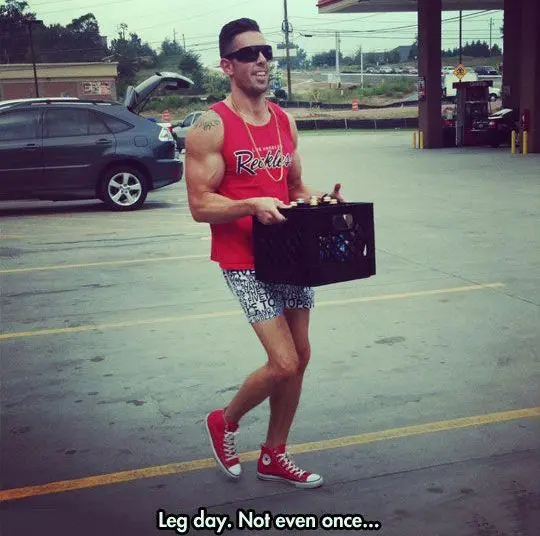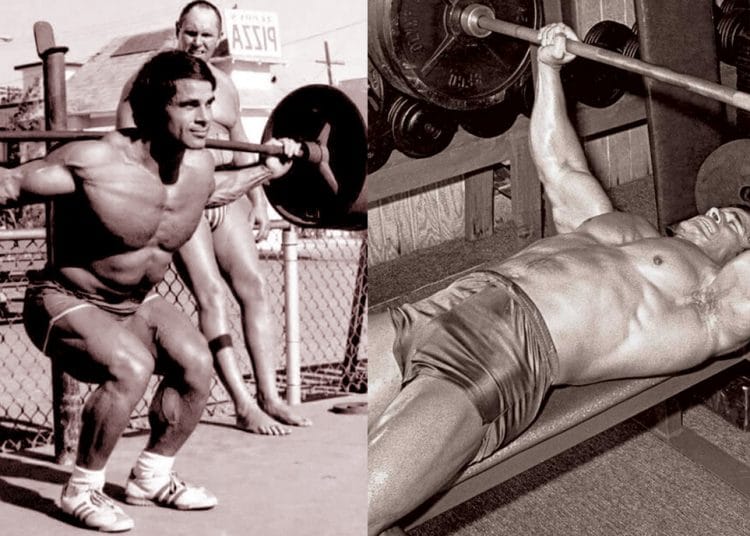“I have no muscle imbalances,” says a noob as he curls a 20lb dumbbell for ten reps with his right arm but can barely manage the same feat with his left. He misses the irony of his statement as he admits his “left side is a little weaker than his main arm.”
The worst part about muscle imbalances? You can never join the army of 300. You shouldn’t even apply for the job unless you want to be kicked into a well by King Leonidas as he shouts “this is Sparta.” You could get the part of Ephialtes of Trachis (the deformed traitor), though.
What are Muscle Imbalances?
Muscular imbalances are probably one of the least talked about problems in the gym. The human body is like any other mechanical machine. It goes through wear and tears as it gets through the day. The impact is amplified if you lift weights.
One side, mostly your main side, is stronger than the other side. For optimal body functioning, the muscle length and strength between opposing muscle groups need to be in balance.
While almost everyone starts with muscular disproportion (even the people who don’t work out face it), you should look at fixing this condition if you want to improve your muscle composition and body posture.
Level Up Your Fitness: Join our 💪 strong community in Fitness Volt Newsletter. Get daily inspiration, expert-backed workouts, nutrition tips, the latest in strength sports, and the support you need to reach your goals. Subscribe for free!
As a car needs rebalancing and alignment after it has done some miles, your body also demands the same if you are into resistance training. If you ever find yourself on a chiropractor’s table, know that they do nothing more than fixing your “alignment” and mechanical disorders of the musculoskeletal system, especially the spine.
Types of Muscle Imbalances
Learning about the different kinds of disproportions can help you avoid and cure the asymmetries. There are two main types of muscular imbalances:
Body Muscular Imbalance
In the ideal case scenario, the muscles on each side of your body should be symmetrical in shape, size, and strength. When a muscle (or group) on one side gets bigger and stronger than its counterparts, you end up with a disproportionate physique. Body muscular imbalance is the more prevalent of the two.
Joint Muscular Imbalance
All your joints are supported and surrounded by muscles. Each of these muscles works together with opposing forces to keep your joint in place and function optimally. When any of these supportive muscles become stronger/weaker or tighter/looser, your joint mobility might take a hit and you’ll have a muscle imbalance. If you have constant pain or experience a stinging sensation in your joints during your workouts – you probably have a muscular imbalance.
Causes of Muscular Imbalances
Exercise
Working out is infamous for causing muscle disproportions. While people who lift talk about and are aware of muscle asymmetries, most people who don’t hit the gym have never heard of the term and automatically think they are immune to it. Through the course of this section, you’ll learn this is not the case.
Muscle imbalances are most widespread amongst gym rookies. They are the result of inexperience and an unbalanced training program. You might see a gym bro with a huge upper body and chicken legs but you’ll never see a pro bodybuilder on stage with a light bulk physique.
Training with improper form is the other culprit which causes imbalanced development. Many lifters run after lifting heavy or copying the big guys at their gym and disregard the correct form and proper technique. Not only does this cause muscular asymmetries, but it also puts them at a higher risk of injury.
Natural Development
Most of us are born neutral but develop disproportion as soon as we pick up a crayon. As we learn to draw, throw and write, we begin developing imbalances as one of our sides becomes dominant. You can only combat this if you foster the ability to use both hands with equal dexterity.
Daily Activities
Thanks to COVID-19, most of us are living the WFM life. Although it’s great to be around your family all day, the new way of life has put us in a sedentary lifestyle. We are either hunched over our computer screens, sitting on our make-shift desks, or are at the least staring at our phones – like you are right now – with our neck bent over like serpents.
Repetitive tasks can also add to the problem. Doing the same motions repeatedly uses the same muscles. This can cause the muscles to become overworked and get stuck in a position of semi-contraction, which may ultimately harm the joints.
You subconsciously do certain things throughout the day that can amplify this problem. Try to identify such patterns in your daily routine. If you carry your gym bag on your right shoulder every day, try switching sides on alternate days. Such small changes can take your progress to a whole new level.
Level Up Your Fitness: Join our 💪 strong community in Fitness Volt Newsletter. Get daily inspiration, expert-backed workouts, nutrition tips, the latest in strength sports, and the support you need to reach your goals. Subscribe for free!
Bad Posture
A desk job can cause serious damage to your posture as prolonged seating can cause your hip flexors to become tight and short. Sitting with slouched shoulders and a rounded back is one of the main reasons for lower back pain. Once you develop an asymmetry, you try to compensate for the weaker muscles by working with the stronger side which in turn widens the disparity between the two.
Genes
Bad genetics are like creepy neighbors, they try to squeeze into everything. If your dad and grandad both have knee issues, you might have a predisposition for experiencing similar problems later in life. This is a case of muscle/joint imbalances forming over time.
Effects of Muscle Imbalances
- Bad Composition
- Muscle Aches
- Cramps
- Impacts Coordination
- Limited Mobility & Pain
- Muscle Imbalances Compound Over Time
- Instability
How To Correct Muscle Imbalances
So you’re tired of being called a light bulb? Frustrated with your pelvic tilt? You can see a vein in your right bicep but the only thing that pops in your left are your hopes? If this sounds like you, you’ve come to the right place. Here are some ways of fixing your muscular assembly:
Balance Weight Training
We don’t want to get your hopes high about the journey to correcting muscle imbalances. Make no mistakes – muscular disproportions are hard to fix and take a long time. Muscle asymmetries take a long time to develop and are the result of long-time bad habits. You can’t expect to amend them in a few weeks.
The first step to straightening out your muscle asymmetries is to acknowledge you have them. The longer you live in denial, the worse your conditioning is going to get. If you lift weights, you should start by altering your form, range of motion, and rep schemes.
Change Repetition Scheme
Let’s take the example of the bicep curls, if you feel you’re stronger on your right side and can do more reps with your right as compared to your left, you should perform 1-2 reps more on your weaker side to bring it up. While this tweak might feel small, and you might not see or feel its results immediately, you’re surely going to reap handsome dividends in the long run.
Read also: Best Methods For Increasing Training Intensity
Unilateral Exercises
Mind-muscle connection plays a huge role in building muscle mass and strength. We generally have a better mind-muscle connection with our dominant side. You might have noticed you get a better pump in your stronger arm as compared to your weaker side while performing the alternate dumbbell bicep curls – that’s your physic powers at work.
If you have trouble connecting with your weaker side, unilateral exercises are an incredibly effective way to boost growth. In unilateral exercises, you complete the desired reps on one side before switching to the opposite side. Unilateral lifts paired with changing rep schemes are a great way of bringing up your lagging muscles.
Read also: The 5 Best Unilateral Leg Exercises
Improve Your Flexibility
A lack of mobility can also be a factor causing muscle imbalances. Flexibility and the range of motion of your joints can impact blood flow. If you lack in any of the two departments, your muscles will not get the required nutrients they need to grow bigger and stronger.
You’ll also need to work on your core strength if you want to address your muscle imbalances. Core strengthening exercises will not only help improve your resistance training, but they can also be instrumental in fixing your posture.
Get Work Done on Your Body
Sometimes, you can’t fix your muscle asymmetries without external help. A physical therapist can provide the needed external stimulus through deep tissue massages, chiropractic adjustments, cupping therapy, and massage guns.
Targeting the lagging muscles through these techniques helps ignite growth and flushes out the toxins from the muscles. Trained eyes are better at finding the muscle discrepancies and figuring out ways of fixing them efficiently.
Go the Opposite Way
A very basic yet effective way of tackling your muscle imbalance is to start your exercises with your weaker side. Most people begin their sets on their stronger side. Using this widespread approach makes you do your first and best rep on your stronger side, and on the other hand, you end the set in exhaustion on your weaker side. Starting with the stronger side and finishing with the lagging compounds over time, and the weak side ends up weaker in the end.
You should also flip your training approach to shock your lagging muscles into growing. If you usually start your workouts with compound exercises, you should switch to beginning with isolation lifts. Alternating between push, pull and compound and isolation days is an optimal way of boosting your results.
Summing Up
If you’re unsure about your muscular balance, asking a professional for his opinion might help. Clicking progress pictures regularly and comparing them with the pros and GOATs can help find your weak spots.
The thing about muscle imbalances is that they might reappear if you go back to your old ways. You need to find the root cause of the problem and make permanent amends to fix your asymmetries for good.














